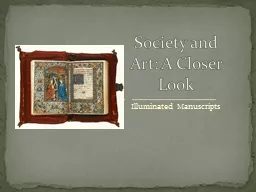

Society and Art A Closer Look Vocabulary Medieval Manuscript A prayer book intended for use in private or family devotions prayers Usually contain a collection of prayers and devotions dedicated to the Virgin Mary and recited or sung at the ID: 271272
Download Presentation The PPT/PDF document "Illuminated Manuscripts" is the property of its rightful owner. Permission is granted to download and print the materials on this web site for personal, non-commercial use only, and to display it on your personal computer provided you do not modify the materials and that you retain all copyright notices contained in the materials. By downloading content from our website, you accept the terms of this agreement.
Slide1
Illuminated Manuscripts
Society and Art: A Closer LookSlide2
Vocabulary
Medieval ManuscriptSlide3
A prayer book intended for use in private or family devotions (prayers)
Usually contain a collection of prayers and devotions dedicated to the Virgin Mary and recited or sung at the canonical "hours" (eight set times during the day). Also added other elements such as a calendar, penitential psalms, litanies, suffrages, etc.
Elaborate versions contain a full cycle of miniatures as well as involved marginal decorations.
Books of hours form the most popular and abundant of all surviving medieval manuscripts.
Book of HoursSlide4
Another term for all handwritten books (manuscripts) on individual leaves of vellum that can be turned and read in succession. Became popular after the scroll
CodexSlide5
grotesque. Animal and human hybrids that inhabit the initials and foliate (leafy) borders of Gothic manuscript leaves.
DrollerySlide6
An enlarged initial containing individual figures or groups that interact; they often form narrative scenes that illustrate or refer to the text they introduce.
Historiated InitialSlide7
Decorated with paintings and drawings, usually ornamented with gold, silver, and brilliant colors.
IlluminatedSlide8
decorator or painter of a vellum codex
IlluminatorSlide9
An emphasized letter at the beginning of a text; used in medieval manuscripts to form breaks within a text and to prioritize the components of the text by drawing the attention of the reader
a purely medieval invention and often lavishly decorated. See also historiated
initial
InitialSlide10
A picture, frequently narrative, used as illustration in a manuscript (from Latin
minium, a red pigment used in manuscript painting).
MiniatureSlide11
The skin of animals (cattle, sheep, or goats) used as manuscript leaves, prepared by soaking and stretching.
Also called vellum, with which it is often used interchangeably.
ParchmentSlide12
Art in Medieval times reflected their societal values
What did they value the most? (Think back to our notes!)RELIGION
This can even be seen in their manuscripts, or handwritten texts.
Medieval ArtSlide13
More medieval books survive from the Middle Ages than any other type of artHand-made books are known as manuscripts
Books that contain artistic decoration are known as illuminated manuscriptsUsually religious texts
Mostly Christian
Some Jewish and
Muslim
texts survive Medieval ManuscriptsSlide14
Medieval manuscript is a codexA book of pages bound between two boards
Pages protected by covers, so more survived throughout the agesAncient scribes wrote on scrolls that were stored in boxesRolls stored in boxes-
Fragile-vulnerable to breaking down, so
only fragments remain
Codex vs
ScrollSlide15
As a reflection of society, most Medieval texts are religious in nature.The works of philosophers such as Plato and Aristotle
The original manuscripts of these works have not survived. They are only known today thanks to Medieval scribes who copied them into codices.
What’s in the books?Slide16
The printing press did not exist in the Middle Ages
How did they record and spread information, then?
All books were copied BY hand (usually by monks) and most were kept in monastery
librairies
Monks traveled to distant monasteries to view and copy books to bring back to their own monasteries.
Many Medieval texts were destroyed in monastery
fires, so not all texts survived the Middle Ages
A slow processSlide17
Illustrated manuscripts are known as illuminated manuscripts.Illustrations were decorative and functional
Marked the beginning of sectionsSometimes told a story (remember- MOST people could not read)
IllustrationsSlide18
http://prezi.com/bs-rt__z09d2/?utm_campaign=share&utm_medium=copy&rc=ex0share
Hey! Check out this Prezi!Slide19
During the Middles Ages, most people could not read. Only very wealthy or scholarly people owned books, which were hand-written and illustrated. While many books were for religious use, there were also books of music, literature, and legends.
Book manufacture involved a number of steps. Pages were made from parchment, a sturdy material produced from treated and cleaned animal skin. Lines were lightly drawn as guides to keep the writing neat. A quill from a large bird would be used for large text, while a quill from a sparrow might be used for fine writings. Areas were reserved for the illuminations, or illustrations. These might include a border decoration (marginalia), enlargement of the first letter of the text decorated with a scene relating to the topic (
historiated
initial), or a miniature painting filling either a quarter, half, or a full page.
REVIEW